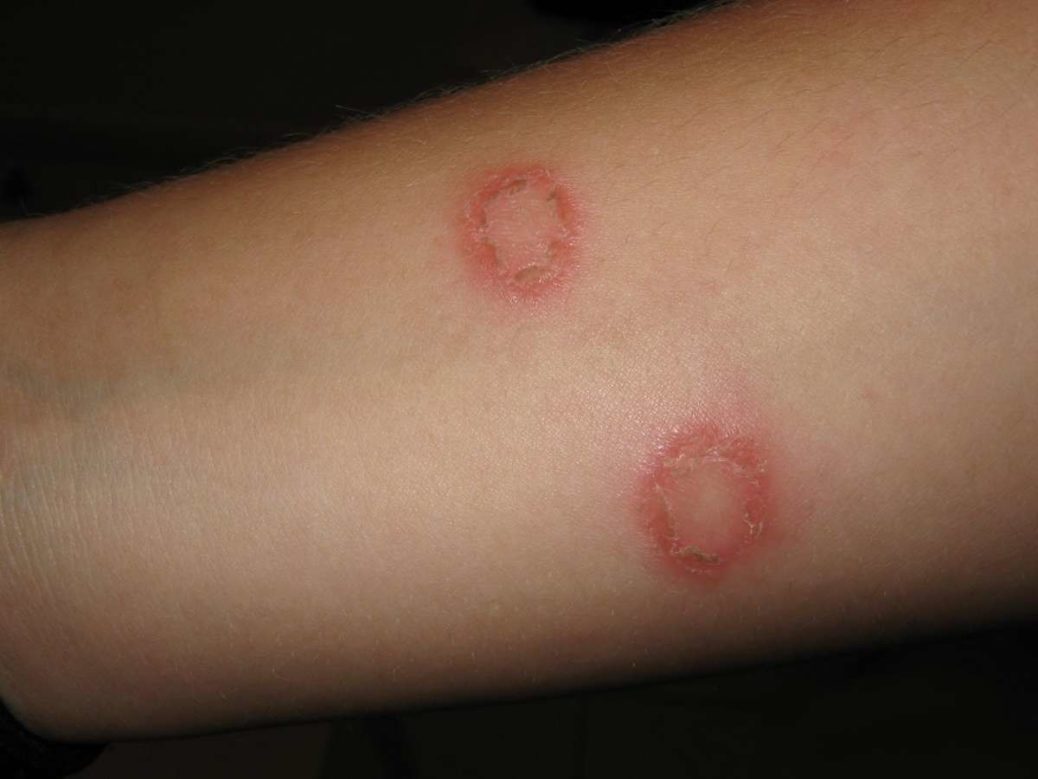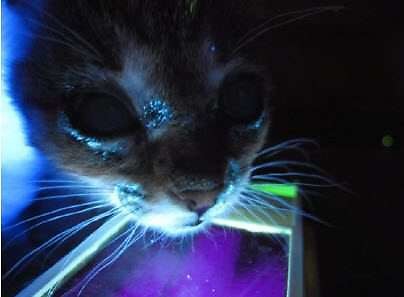Ringworm is not a worm at all and is not just for cats either. Ringworm is a fungal organism that occurs in humans and in animals. While fairly benign in most cases, children and immunosuppressed people are more susceptible. The following discussion on signs, diagnosis and treatment of ringworm will help you manage this problem in your pets.
Ringworm is a fungal skin lesion in the dermatophyte family. It is not creepy little worm that lives under the skin, as the name suggests. It is common in cats and in people, and the spores can be found in most environments. Because it can easily be transferred between species it is considered zoonotic. This fungal organism is closely related to dandruff and tinea, or athlete’s foot in humans.
What does it look like?
Ringworm in animals causes patchy areas of hairloss, with damaged broken hairs. The skin often has a circular rim around the edges of the lesion. It can be slightly crusty or flaky, but is not usually itchy. The typically circular red ring that appears in humans is how it got the name ringworm. Sometimes the presentation is a little more unusual, and in some cases the areas around the nail beds are affected.
Can I get it from my cat?
Ringworm can come directly from a cat or from the environment. Spores are very resistant and can survive more than a year in the right conditions either indoors or outdoors. Most environments will have low numbers of dermatophytes, particularly in soil, but this becomes a problem if an infected animal (whether that be a pet, pest or native animal) is shedding large numbers of infective spores. Sometimes cats are blamed unnecessarily, however up to 20% of cats can be asymptomatic carriers, and most cases of ringworm are the species that cats tend to carry. If you do happen to get any interesting skin lesions visit your doctor and take your cat to the vet.

Your cat may be carrying the fungal spores, but not actually showing any signs, so it is important to identify the source of the infection. If your cat is not positive for ringworm, it is likely you got it from somewhere else (another animal or from the environment).
What should I do if I suspect my cat has ringworm?
Firstly visit your vet who will recommend some tests to make sure it is ringworm. Many skin problems can look very similar, so even if your skin looks similar to those pictures on the internet, make sure you have the right diagnosis. Isolate any cats who have skin lesions to avoid spreading the spores throughout the house and avoid contact with elderly, children or immunosuppressed people (such as those undergoing treatment with immunosuppressive drugs, chemotherapy or with HIV/AIDS). Although most people only develop very minor skin irritations from ringworm, those that do not have a competent immune system can develop serious disease, even lung problems.
Diagnosis
Your Veterinarian may use a special lamp called a Wood’s lamp to help diagnose ringworm. This test involves holding an ultraviolet light over the lesion and looking for bright green fluorescence.

A negative Wood’s lamp test does not completely rule out ringworm, as only 50% of species will glow, but it is a good first step. Your Vet may then get some samples of hairs either via a toothbrush or from the lesions and place them on a special fungal culture medium. It takes 14 days to rule out ringworm via a fungal culture, so your Vet may recommend antifungal treatment in the meantime just in case. For more unusual patches of skin it may be necessary to perform a biopsy to diagnose ringworm.
I have children, what should I do?
Children and elderly people are more at risk of contracting ringworm. The fungus is very common and not everyone who is exposed to it will get skin problems. This goes for both cats and humans. Kids tend to not have a fully functional immune system, so are more prone to developing disfiguring lesions. They can be exposed via the cat directly or from the common environment. Ask your kids not to pat the cat until a diagnosis is obtained and treatment is completed and isolate your cat to one easy to clean room in the home. Speak to your vet about how to get rid of fungal spores in the house.
How is ringworm treated?
Ringworm can be treated with antifungal shampoos, creams and tablets. The treatment does not actually kill the fungus entirely, but stops it multiplying. This allows the immune system to get the upper hand and kill off the fungus. Your Vet will recommend a course of treatment based on the severity of the signs in your pet. In many cases ringworm will improve within a few months even without treatment, but this may depend on a number of factors, including how old your pet is, how strong their immune system is and how extensive the ringworm infection is.
How to treat the environment
Environmental treatment is key to reduce the likelihood of your pet getting ringworm again from latent spores that can last up to 18 months in the right conditions. The key is thorough cleaning and disinfecting with bleach.
- Cleaning is easier if you confine your pet to one room.
- Vacuum each area for 10 minutes daily and throw out the vacuum bag.
- Steam clean carpets.
- Bleach surfaces with a 1:10 ratio of bleach and water, allowing 10 minutes contact time.
- Wash clothing, bedding and soft furnishing with a fungal wash.
- Dispose of anything that can’t be cleaned with the above methods.
- Throw away brushes if they cannot be adequately cleaned.
- Bleach and vacuuming will need to be repeated at least once even if the pet has been removed from the area being cleaned.
- To confirm your environment is clean, you can take a sample from an electrostatic cleaner such as a Swiffer by placing the Swiffer rag into a bag and taking it to your Vet for testing.
How do I know I have successfully treated ringworm?
In order to know whether your treatment has been successful, your Vet will recommend a repeat culture, and technically two negative cultures are required before it is confirmed the disease has completely resolved. You can also ask your Veterinarian to confirm you have successfully cleared your environment of spores (by using the Swiffer technique). If your pet looks otherwise well, your Vet will use a toothbrush to take a sample from all over the coat. Getting a true negative diagnosis is particularly important if you have multiple cats and children.
What if I do nothing?
Because dermatophytes are everywhere and many pets and humans who are exposed to the organism do not get skin problems, it may not be necessary to aggressively treat. So long as your pet is otherwise healthy small lesions should resolve within 4 months. The issue with doing nothing is that your pet will continue to shed the organism into the environment, increasing the risk of humans and other pets getting the disease. At the very least a shampoo and environmental control will help to ensure the infection is limited.
Key points:
- Ringworm is a fungal disease closely related to tinea.
- Ringworm is a common condition and generally thought to be self-limiting.
- Not all humans and pets exposed to ringworm in the environment will get ringworm.
- Ringworm occurs more commonly in young humans and animals or those that are immunosuppresed.
- Get a diagnosis from your Vet if you suspect ringworm, as it looks similar to other skin problems.
- If anyone in your family gets ringworm, take your cat to the Vet, even if there are no signs.
- Treatment involves a combination of topical, oral and environmental treatment.





